
Australia signs deal with NASA to send a rover to the moon
Last Updated on December 24, 2022 by Admin
[ad_1]

Shutterstock
The Australian government has signed an agreement with NASA that will see an Australian-built semi-autonomous rover be included in future missions to the moon, and eventually Mars.
According to the Australian Space Agency, the “foundation services” rover will be used to help collect lunar soil, known as regolith, which will then be examined for oxygen to see whether it could be used to support human life in space, and “ultimately support permanent outposts”.
The rover is expected to be capable of operating on the moon, be able to provide lunar regolith to a NASA payload with a “high level of autonomy”, and weigh 20kg or less. There are plans to see the rover launched into space as early as 2026.
The rover is expected to be developed by an “industry-led consortium” of Australian businesses and research organisations, particularly those from the resources and mining sector, with support from international partners to also be welcomed.
“This is a key step towards establishing a sustainable human presence on the Moon, as well supporting future missions to Mars,” the ASA said.
“The mission will demonstrate Australian industry’s world leading skills and experience in remote operations and autonomous systems.”
While the project will be delivered by the Australian government’s AU$150 million Moon to Mars initiative under the soon-to-be launched Trailblazer program, the successful consortium will also be expected to chip in to fund the project.
The ASA noted the financial contribution to be made by the consortium will be an “important factor” in the assessment criteria.
Last month, ASA boss Enrico Palermo highlighted that Australia has the potential to be a central location for future space launches, based on the country’s track record of being a key player in in other major space expeditions.
“I think we sometimes describe ourselves too much as an emerging space sector. We have an agency that is only three years old, but we’ve got a really tremendous heritage to build on as part of the story that we need to tell more,” he said.
Palermo also highlighted that government has a crucial role to play in helping Australia’s space sector succeed. Besides offering funding grants to companies looking to start up in the space sector, government can also be an anchor customer, he said.
“Because it is proven out to be a successful model,” Palermo said.
Final details of the proposed mission and rover will be provided when the Trailblazer program launches later this year, the government said.
RELATED COVERAGE
[ad_2]
Source link




